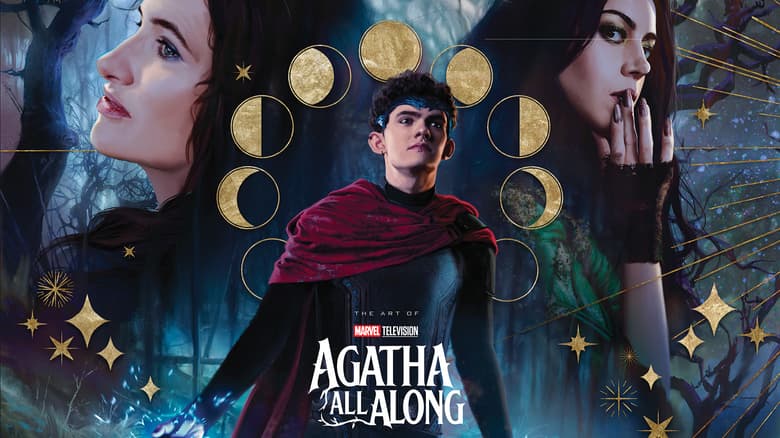How ‘Agatha All Along’ Crafted ‘The Ballad of the Witches’ Road’
Award-winning songwriters Robert Lopez and Kristen Anderson-Lopez explain how nursery rhymes and Stevie Nicks inspired their witchy new hit.
Warning: This story contains spoilers for Agatha All Along.
Has “The Ballad of the Witches’ Road” been stuck in your head for weeks? You have Robert Lopez and Kristen Anderson-Lopez to thank.
The two award-winning songwriters crafted the music for Marvel Television’s Agatha All Along, imbuing the series with its signature witchy vibe. The Lopezes previously wrote for WandaVision, penning that show’s memorable theme songs and the Emmy-winning breakout hit “Agatha All Along.” So, when series creator Jac Schaeffer reached out about a new show, they jumped at the chance to write for Agatha Harkness again.
“Jac has this innate talent for how music can work within a story, in a way that’s different from musical theater but still really powerful,” Robert Lopez tells Marvel.com. “She loves music. She understands a lot about it without being a musician herself. She knows exactly what it’s doing in her story.”

The Lopezes’ assignment was to create a memorable melody that could take different forms throughout the show: In the very first episode, “The Ballad of the Witches’ Road” is reimagined as a twangy theme song for a fake true-crime detective series. Then, Agatha (Kathryn Hahn) gathers her coven for the “Sacred Chant” version, a witchy acapella performance to summon the Road itself. Later, Alice Wu-Gulliver (Ali Ahn) leads the coven in a 1970s-inspired rock ‘n’ roll performance, surrounded by flames and screeching demons.
But when writing the ballad, the Lopezes went all the way back to the song’s origin. In the final episode, it’s revealed that the ballad started as a simple, made-up walking song, created centuries ago by Agatha Harkness and her young son Nicholas Scratch (Abel Lysenko).
“We certainly made up so many of those with our kids when they were little,” Lopez explains. “So, we knew [the ballad] had to have this nursery rhyme quality to it… Honestly, most pop hits are nursery rhymes. They’re so simple, and they’re so unforgettable.”
One of the trickiest renditions to get right was the 1970s-inspired version, first performed by Alice’s rock star mother Lorna Wu and later by the coven. Lyrically, Anderson-Lopez approached the ‘70s ballad as a puzzle, wanting it to simultaneously function as a love song, a protection spell, and a window into Agatha Harkness’ mind.
“I highlighted specific words and channeled them into a ‘70s version of a love song, where someone is like, ‘Are we going to stay in this relationship or not?’” she explains. “Which I think ultimately is the big theme of what Agatha deals with: Agatha is always toggling between ‘Am I going to be vulnerable and truly connect with someone?’ or ‘Am I a witch who walks alone?’ That was easy to channel into a love song.”

For additional inspiration, Schaeffer suggested that the Lopezes look at the iconic Fleetwood Mac song “Silver Springs,” written by Stevie Nicks. She also sent them a classic clip of Nicks performing the song for the 1997 live concert film The Dance.
“I don’t think I really knew [“Silver Springs”] that well,” Lopez says. “There’s that one live recording of it where she sings it right at Lindsey Buckingham. He looks up at her at one point, and they lock eyes. Jac was like, ‘I want that kind of drama. I want that intensity. I want that kind of spell to cast through music.’ That was a lot to live up to. It was a big learning thing for us because we didn’t really know Stevie Nicks that well, and now, boy, are we fans.”
The Lopezes also found inspiration in their own musical backgrounds. Both songwriters grew up singing centuries-old religious music, which helped shape the sacred chant version of the ballad. (In college, Lopez would perform Gregorian chants in churches for pocket money, and Anderson-Lopez sang with an early Renaissance acapella group.) They also wanted the ballad to feel like it naturally evolved through the decades, so they carefully studied American musical traditions, tracking how early Gilbert and Sullivan melodies turned into ragtime and jazz, before shifting into blues, rock ‘n’ roll, and pop.
“Every version of [the ballad] needs to cast its own spell,” Lopez says. “If it’s the blues, it’s a laidback guitar part. In the sacred chant, it’s that bell that sends shivers down your spine. Then, in the Lorna Wu version, another reference song for me was ‘Hotel California,’ which features the 12-string acoustic guitar.”
Careful listeners will also notice some intriguing details hidden within. For the WandaVision theme song, the Lopezes relied heavily on a musical interval known as a tritone, a.k.a. “the Devil’s Chord” — a way to hint that magic was afoot in the seemingly idyllic Westview. Similarly, “The Ballad of the Witches’ Road” hints at Agatha’s complicated personality.
“For the ballad, I was thinking that Agatha is this antihero who you never really know,” Lopez says. “She’s so mischievous. Sometimes she surprises you with how kind she is — and sometimes how mean she can be. We wanted to play with light and dark, so we’re constantly changing the mode of the song from major to minor. That’s part of what gives this very simple tune a little bit of richness. It makes it more than just a nursery rhyme or a song that’s written to mimic a style.”
Anderson-Lopez also carefully tweaked every lyric to make it feel true to the appropriate time period.
“In the ‘70s version, you’re looking at modern-day English, but for the sacred chant, I went and found all these Wiccan texts,” she says. “I just looked at how they combine [words] and how they use the language. It was affected by early English language, so we used a few of those details to give it its time.”
But ultimately, the Lopezes say, it was the cast who brought real magic to the ballad.
“Kathryn has this leadership,” Kristen Anderson-Lopez says. “She really did step in as number one on the call sheet and create this sense of play and witchiness. She brought a deck of tarot cards to the first day they were all in costume to sing the chant. She brought everyone together.”
Agatha All Along is now streaming on Disney+. For more from the Lopezes, listen to The Official Marvel Podcast.
The Hype Box
Can’t-miss news and updates from across the Marvel Universe!








